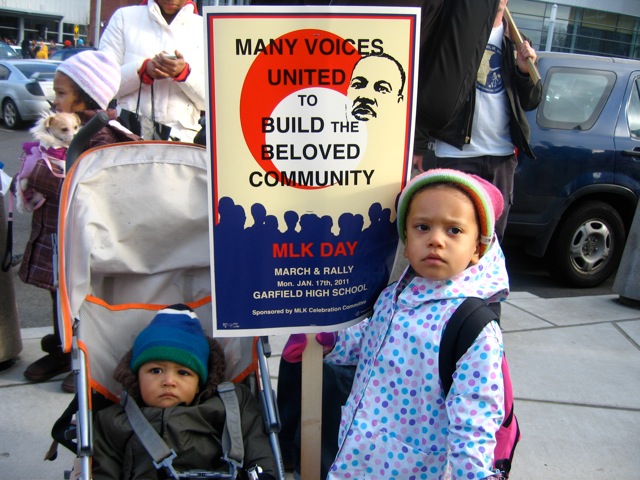 I want my kids to grow up surrounded by all kinds of people.Photo: Carla Saulter“We may have all come on different ships, but we’re in the same boat now.” — Martin Luther King, Jr.
I want my kids to grow up surrounded by all kinds of people.Photo: Carla Saulter“We may have all come on different ships, but we’re in the same boat now.” — Martin Luther King, Jr.
My favorite holiday, hands down, is Martin Luther King Day. This is partly because I share a birthday with Dr. King and therefore like to think of the celebration (and even Stevie Wonder’s famous MLK Day song) as sort of mine, too. It’s partly because it’s one of the few holidays that isn’t promoted as an occasion to buy stuff or celebrate a particular association. But it’s mostly because the King holiday is the only day I know of that we set aside to honor peace, justice, and service. What’s not to like?
Every year, our family celebrates MLK Day by participating in as many of the local events as we can manage to attend. The number we can squeeze in depends on many factors, including what time and where they take place, holiday bus availability, and how well rested the little ones are. But the event we never miss is the annual rally and march.
Seattle’s march is one of the biggest in the country and happens to start right in our neighborhood. There are other events that are more constructive (such as organized volunteer efforts) or less exposed to the elements (such as a local arts organization’s amazing staged readings of his speeches), but they don’t mean as much to me as the march. There’s something about being surrounded by thousands of people who’ve given up their days off (or, as in my husband’s case, who’ve explicitly taken the day off) to raise their voices in support of King’s vision.
Each year, Seattle’s MLK Day march has a theme that exemplifies a particular aspect of Dr. King’s philosophy. This year, it was “Many Voices United to Build the Beloved Community.” The theme was chosen, I assume, because of the recent death of Roberto Maestas, a local leader who was a champion of the concept, but I can’t think of a better way to describe what happens at those marches. King used the term “beloved community” to articulate a particular vision, so forgive me if I take a little creative license and present my own interpretation.
The march-goers run the gamut — old-school civil rights leaders, peace activists, members of historically black fraternities and sororities, schoolchildren, religious groups, artists, community organizers, political types looking to sell themselves to a captive audience, and folks who just want a way to honor what King stood for. They show up in the pouring rain or biting cold, holding handmade signs, leashes, and children’s hands. They bring megaphones. They bring instruments. They bring umbrellas and extra gloves. All of us walk together, in the street, past the familiar landmarks we love, remembering a man who inspired us. And in this spirit of camaraderie we are moved to introduce ourselves to people we’ve seen — sometimes dozens or hundreds of times — in other contexts. We leave feeling closer to our community, reminded of our interdependence and of our collective power.
This is why I am drawn to the march year after year, and why I will continue to bring my children. It is also why I am, and have always been, drawn to cities. Though I try to use this column to share the benefits (and address the challenges) of raising children in urban environments, the practicalities are somewhat beside the point for me. For me, the point is beauty of the city — a beauty that extends beyond a lovely skyline or great theaters and restaurants — that is manifested in the incredible mix of humanity represented in its residents.
I want my children to be surrounded by elders and infants, artists and laborers, students and teachers. By immigrants and First People, people who look just like them and people who look different. People who speak their language and people they must stretch to communicate with. I want them to pass street performers on the way to the bus stop. I want them to feel at home in a crowd of strangers. I want them to understand that a man can love another man the same way that Daddy loves Mommy. I want all this for them because they need to know how to make their way in a complex and diverse world, but also because it’s beautiful.
What concerns me more than the number of parks per square mile or ease of access to enrichment activities is whether this beauty will exist in 10 years. As we rethink our way of life, as cities become more desirable and “urban” is no longer considered a dirty word, we must not overlook the reasons we love them. I’m all for walkability and transit-oriented development and mixed use and many of the other New Urbanism hallmarks that are influencing urban revitalization efforts across the country. But I also know we must figure out how to make our cities more livable and sustainable without triggering the seemingly invitable march of gentrification. Because cities don’t become what they are solely because of urban design. Without diversity — of age, income, ethnicity, occupation, and ideas — they will lack the soul that makes them places people want to be.
The city I want for my children is all about community. The beloved community.



